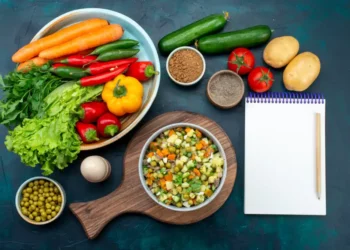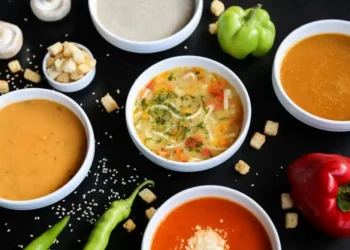Table of Contents
1 Introduction to Family-Friendly Vegan Cooking
Embarking on a journey of family-friendly vegan cooking is not just about altering your diet; it’s about embracing a lifestyle that is healthful, compassionate, and environmentally conscious. Vegan recipes offer a fantastic way to bring the whole family together, providing meals that are as nourishing as they are delicious.
In today’s fast-paced world, families are constantly looking for meal solutions that are quick, nutritious, and appealing to all, from the pickiest of toddlers to the most health-conscious adults. This is where vegan cooking shines. It presents a plethora of options that cater to varied tastes and nutritional needs, making it a perfect fit for families of all sizes and ages.
Why Choose Vegan Recipes for Your Family?
Vegan recipes are not just salads and smoothies; they are a vibrant, diverse collection of dishes that can replicate the flavors and textures of traditional family favorites, but with plant-based ingredients. By choosing vegan recipes, you’re opting for meals that are typically lower in saturated fats, free from cholesterol, and packed with essential nutrients derived from fruits, vegetables, grains, and legumes. This switch can lead to better health outcomes for your family, including reduced risks of heart disease, obesity, and certain types of cancer.
Moreover, family-friendly vegan cooking is a wonderful way to instill values of kindness and environmental stewardship in children. It opens up conversations about where our food comes from and how our choices impact the world around us.
Making Vegan Cooking Fun and Engaging
One of the joys of vegan cooking is its inherent creativity. From crafting the perfect veggie burger to experimenting with dairy-free desserts, there’s always something new and exciting to try. This variety ensures that meals are never boring and always a learning experience for both young and old.

The Ease of Vegan Cooking
Contrary to popular belief, vegan cooking doesn’t have to be complex or time-consuming. Many vegan recipes are simple, with ingredients that are readily available at your local grocery store. There are also numerous quick and easy vegan recipes that can be prepared in under 30 minutes, perfect for busy weeknights.
2 Nutritional Benefits of Vegan Recipes
Vegan recipes are much more than just a trend; they are a gateway to a diet rich in diverse nutrients essential for maintaining good health. Embracing veganism doesn’t mean sacrificing nutritional value; in fact, it often leads to a more nutrient-dense diet compared to traditional eating habits. Let’s delve into the nutritional benefits these plant-based meals offer.
Rich in Essential Nutrients
One of the most significant benefits of vegan recipes is their high content of essential nutrients. Plant-based diets are typically rich in dietary fiber, antioxidants, vitamins, and minerals. Fiber, found abundantly in fruits, vegetables, and whole grains, aids in digestion and helps maintain a healthy gut. Antioxidants, which are prevalent in a variety of fruits and vegetables, play a critical role in combating free radicals, thereby reducing the risk of chronic diseases.
Low in Unhealthy Fats
Vegan recipes naturally contain lower levels of saturated fats. By excluding meat and dairy products, these recipes help in reducing the intake of unhealthy fats, which are linked to heart disease and high cholesterol. Instead, vegan diets promote the consumption of healthier fats, like those found in nuts, seeds, and avocados, which are beneficial for heart health.
Ideal for Weight Management
Many find that adopting vegan recipes leads to easier weight management. Plant-based meals are generally lower in calories and higher in fiber than meat-based dishes, contributing to a feeling of fullness and reducing the likelihood of overeating.

Supports Overall Health
Regular consumption of vegan recipes contributes to overall health. Studies have shown that a vegan diet can lower the risk of chronic diseases such as heart disease, diabetes, and certain types of cancer. Additionally, it can lead to better blood sugar control and improved kidney function.

Concluding Thoughts
Incorporating vegan recipes into your diet can significantly boost your intake of essential nutrients while avoiding the pitfalls of unhealthy fats and excess calories. The result is a diet that not only tastes good but also contributes to a healthier, more vibrant lifestyle.
3 Easy and Quick Vegan Recipes
Incorporating easy and quick vegan recipes into your daily routine can be a delightful and stress-free experience. The beauty of vegan cooking lies in its simplicity and the speed with which delicious and nutritious meals can be prepared. Here, we explore how simple ingredients can be transformed into quick vegan delights that the whole family can enjoy.
The Joy of Quick Vegan Meals
One of the biggest misconceptions about vegan cooking is that it’s time-consuming. However, there are countless vegan recipes that can be whipped up in 30 minutes or less. These meals are not just quick but also packed with nutrition, flavor, and variety.
Ingredients: Simple and Accessible
Most easy vegan recipes use ingredients that are readily available in most kitchens or local supermarkets. Staples like beans, lentils, pasta, rice, fresh vegetables, and simple herbs and spices can create an array of dishes without the need for extensive preparation or cooking time.
One-Pot Wonders
One-pot vegan recipes are a lifesaver for busy days. Dishes like chili, curries, and stews can be cooked in a single pot or pan, reducing both cooking time and clean-up. These recipes often involve just adding all the ingredients to the pot and letting them simmer to perfection.

Quick Breakfasts and Snacks
Starting the day with a quick vegan breakfast or grabbing a vegan snack on the go is easier than you think. Smoothies, oatmeal bowls, or avocado toast are not only quick to prepare but also nutritious and filling.
Speedy Salad and Bowl Meals
Salads and bowl meals can be both quick to assemble and endlessly versatile. A mix of fresh vegetables, grains, and a protein source like tofu or tempeh can be tossed together to create a wholesome meal in minutes.

Easy and quick vegan recipes are the perfect solution for anyone looking to eat healthily without spending hours in the kitchen. These recipes demonstrate that vegan cooking can be fast, simple, and delicious, making it an ideal choice for busy individuals and families.
4 Kid-Friendly Vegan Meals
When it comes to feeding children, finding the right balance between nutritious and appealing can be a challenge, especially with vegan meals. Kid-friendly vegan meals are all about combining healthfulness with flavors and presentations that are sure to win over the younger crowd.
Appealing to Young Palates
Kids are often drawn to foods that are colorful, varied in texture, and familiar in taste. Vegan recipes can easily cater to these preferences. Dishes like veggie-packed pasta, colorful smoothie bowls, or homemade veggie burgers can be both nutritious and appealing to children.

Nutritionally Balanced
Ensuring that vegan meals are nutritionally balanced is crucial for growing children. Incorporating a variety of fruits, vegetables, whole grains, nuts, seeds, and legumes can provide the essential nutrients needed for their development.
Creative and Fun Presentations
Getting kids excited about vegan meals often requires a bit of creativity. Fun presentations, like shaping foods into animals or using colorful veggies to create a rainbow plate, can make mealtime more engaging and enjoyable.

Familiar Favorites with a Vegan Twist
Children often gravitate towards familiar foods. Preparing vegan versions of classic favorites like pizzas, tacos, or pancakes can make the transition to vegan meals easier for kids. Using plant-based cheeses, meat alternatives, and creative toppings can make these dishes both kid-friendly and vegan.
Involving Kids in the Cooking Process
Involving children in meal preparation can increase their interest in vegan foods. Simple tasks like washing vegetables, stirring batter, or assembling their own plates can be both educational and fun.
Creating kid-friendly vegan meals is about finding the sweet spot where nutrition meets fun and flavor. With a little creativity and a focus on balance, vegan meals can be both a joy for kids to eat and a peace of mind for parents knowing their dietary needs are met.
5 Seasonal Vegan Recipes
Embracing seasonal vegan recipes is a delightful way to enjoy the freshest produce while aligning with nature’s cycles. These recipes not only offer peak flavor and nutritional value but also contribute to sustainable eating practices. Let’s explore the benefits and possibilities of seasonal vegan cooking.
Maximizing Freshness and Flavor
Seasonal fruits and vegetables are at their peak of freshness, meaning they’re not only more flavorful but also more nutritionally dense. For instance, a summer salad made with ripe tomatoes and crisp cucumbers from the local farmer’s market can offer a taste experience that’s hard to replicate with out-of-season produce.

Supporting Local Agriculture
Using seasonal ingredients in vegan recipes also means supporting local farmers and reducing your carbon footprint. Foods that don’t have to travel long distances are better for the environment and often more economical.
Diverse and Creative Cooking
Each season brings its own variety of produce, encouraging creativity in the kitchen. Spring might inspire light vegetable stir-fries or fresh salads, while autumn calls for comforting soups and roasted vegetable dishes.
Planning Meals Around Seasonal Produce
Planning your vegan meals around what’s currently in season can be an exciting culinary adventure. It encourages a deeper connection with the food you eat and a greater appreciation for the earth’s natural rhythms.
Educating and Inspiring
Seasonal vegan cooking can also be a great opportunity to educate family and friends about the benefits of eating seasonally and sustainably. It’s a chance to share not just delicious meals, but also the stories and origins behind the ingredients.

Seasonal vegan recipes offer a world of flavors, textures, and nutrients, all while supporting environmental sustainability and local communities. By embracing the rhythm of the seasons, you can create a vegan diet that is as varied and vibrant as nature itself.
6 Vegan Alternatives to Family Favorites
Transitioning to a vegan lifestyle doesn’t mean giving up on the classic family favorite dishes. With a little creativity and the right ingredients, you can recreate these beloved meals using entirely plant-based alternatives. Let’s delve into how vegan recipes can provide delicious and healthy substitutes for popular family dishes.
Reinventing Classic Meals
The key to successful vegan alternatives lies in replication of texture and flavor. For instance, lentils or textured vegetable protein can replace ground beef in dishes like spaghetti bolognese or tacos. Similarly, chickpeas or jackfruit can be used as substitutes in recipes like chicken salad or pulled pork sandwiches.

Dairy and Egg Substitutes
Dairy products and eggs are common in many favorite recipes, but there are several plant-based options available. Nutritional yeast, cashews, and plant-based milks can be used to create creamy sauces and cheese alternatives. Flax or chia seeds soaked in water can act as a binding agent in baking, similar to eggs.
Taste and Seasoning
Seasoning is crucial in vegan cooking to replicate familiar flavors. Herbs, spices, and umami-rich ingredients like soy sauce or miso paste can add depth and richness to vegan dishes, making them just as satisfying as their non-vegan counterparts.
Healthy and Satisfying
Not only are these vegan alternatives cruelty-free, but they also tend to be lower in saturated fats and cholesterol, making them healthier options. This shift can be especially beneficial for families looking to improve their overall diet without sacrificing taste or satisfaction.
Getting Creative with Desserts
Desserts are an integral part of family favorites, and vegan recipes don’t disappoint. From decadent chocolate cakes to creamy ice creams, there are numerous plant-based options that are just as indulgent and satisfying.
Vegan alternatives to family favorites are not just possible; they can be equally, if not more, delicious. With these plant-based options, you can enjoy all your favorite meals while adhering to a vegan lifestyle, ensuring that no one at the table misses out on the foods they love.
7 Vegan Desserts and Treats
Indulging in desserts and treats is a universal joy, and adopting a vegan lifestyle doesn’t mean you have to miss out on this. Vegan desserts and treats can be just as delectable and satisfying as their traditional counterparts, offering a world of flavors without any animal products. Let’s explore the delightful realm of vegan sweet treats.
Rich and Decadent Cakes and Pastries
One might assume that cakes and pastries require dairy and eggs, but vegan baking has evolved tremendously. Ingredients like applesauce, mashed bananas, or avocado can substitute for eggs, while plant-based milks and oils can replace dairy. The result? Rich and moist cakes, fluffy cupcakes, and crispy pastries that everyone can enjoy.

Healthy and Guilt-Free Options
For those who prefer healthier alternatives, there are numerous options in vegan baking. Ingredients like dates, nuts, oats, and coconut are often used to create treats that are not only delicious but also nutritious. Think energy balls, raw bars, and fruit-based desserts.
Frozen Vegan Delights
Ice cream is a beloved treat, and vegan versions are no exception. Made with bases like coconut milk, almond milk, or cashew cream, vegan ice creams come in a variety of flavors and are just as creamy and indulgent as traditional ice cream.
Innovative Treats and Snacks
The world of vegan desserts is not just limited to traditional sweets. Innovations like aquafaba (the liquid from canned chickpeas) allow for the creation of vegan meringues and marshmallows. There’s also a wide range of dairy-free chocolates and candies available in the market.
Baking and Cooking with Kids
Vegan dessert recipes can be a fun way to engage kids in the kitchen. Simple recipes like no-bake cookies or fruit sorbets are not only easy to make but also a great opportunity for children to learn about plant-based ingredients.
Vegan desserts and treats are a testament to how versatile and imaginative plant-based cooking can be. Whether you’re craving something rich and indulgent or looking for a healthy sweet snack, the world of vegan desserts offers something for every palate.
8 Batch Cooking and Meal Prep for Vegan Families
For busy vegan families, batch cooking and meal prep can be lifesavers. These practices not only save time and reduce daily stress but also ensure that healthy, plant-based meals are always at hand. Let’s dive into how batch cooking and meal prep can be seamlessly integrated into the lifestyle of a vegan family.
The Basics of Batch Cooking
Batch cooking involves preparing large quantities of meals at once, which can then be stored for future use. This is particularly useful for vegan families, as many plant-based dishes like stews, soups, and casseroles lend themselves well to being made in big batches and freeze beautifully.
Meal Prep: Planning Ahead
Meal prep is slightly different, involving the preparation of individual meal components ahead of time. This might include washing and chopping vegetables, cooking grains and legumes, or making sauces and dressings. When meal times come around, it’s just a matter of assembling the prepped ingredients into a dish.
Saving Time and Reducing Waste
One of the biggest advantages of batch cooking and meal prep for vegan families is the time saved during busy weekdays. Having meals ready to go or ingredients prepped and waiting can be a huge relief. It also helps in reducing food waste, as you only prepare what you know will be consumed.

Diverse Meals Throughout the Week
With a bit of creativity, a single batch-cooked item can be turned into various meals throughout the week. For example, a big pot of chili can be eaten as is one day, served over baked potatoes another, and used as a filling for tacos later in the week.
Involving the Whole Family
Meal prep and batch cooking can also be family activities. Getting kids involved in the planning and preparation not only teaches them valuable skills but also makes them more likely to eat the meals they helped create.
Conclusion
For vegan families, batch cooking and meal prep are not just about saving time; they’re about ensuring that nutritious, plant-based meals are a constant in the busy rhythm of family life. Embracing these practices can lead to healthier eating habits and a more enjoyable mealtime experience for everyone.
9 Vegan Nutrition for Different Age Groups
Adopting a vegan lifestyle is a healthy choice for individuals of all ages, but it’s important to ensure that the nutritional needs specific to different age groups are met. Vegan nutrition can be tailored to support growth, development, and overall health throughout the various stages of life.
Children and Adolescents
In growing children and adolescents, adequate nutrition is crucial. A vegan diet for this age group should focus on protein, calcium, iron, and vitamin B12, which are essential for growth and development. Plant-based sources like beans, lentils, tofu, fortified plant milks, and whole grains are excellent choices.

Adults
For adults, maintaining a balanced vegan diet helps in promoting overall health and preventing chronic diseases. Key nutrients include omega-3 fatty acids, found in flaxseeds and walnuts, and antioxidants, abundant in fruits and vegetables. It’s also important for adults to ensure they get enough vitamin D, either from fortified foods or sunlight exposure.
Seniors
As people age, their nutritional needs change. Seniors on a vegan diet should focus on protein to maintain muscle mass, calcium and vitamin D for bone health, and B12 for cognitive function. Foods that are easy to chew and digest, like smoothies and soups, can be particularly beneficial.
Pregnant and Nursing Women
Pregnant and nursing women have increased nutritional demands. A well-planned vegan diet can provide all the necessary nutrients, like iron, folate, calcium, and vitamin D, essential for the health of both the mother and the baby. It’s often advisable for women in this group to consult a healthcare provider or a dietitian to ensure their diet meets their increased needs.
Athletes
Vegan athletes can perform at their best by focusing on protein, carbohydrates, and hydration. Protein is crucial for muscle repair and growth, while carbohydrates are needed for energy. Hydration is also key, as plant-based diets are often high in fiber, which can increase water needs.

Vegan nutrition can be adapted to suit the needs of individuals at any stage of life, from infancy to old age. By focusing on nutrient-dense foods and ensuring a variety of sources, a vegan diet can support healthy growth and development throughout all life’s stages.
10 Involving Kids in Vegan Cooking
Involving kids in vegan cooking is not only a fun activity but also an educational experience that can instill healthy eating habits and a love for nutritious food. By participating in the preparation of vegan meals, children can learn about the importance of a plant-based diet and the variety of ingredients it encompasses.
Making Cooking a Learning Experience
Cooking with kids provides an excellent opportunity to teach them about different fruits, vegetables, grains, and legumes. Discussing the nutritional value and origin of these ingredients can be a great way to spark their interest in healthy eating and the environment.

Simple and Safe Tasks for Children
Start by assigning simple tasks such as washing fruits and vegetables, tearing lettuce for salads, or stirring ingredients in a bowl. These activities are safe and engaging for children, giving them a sense of involvement in the meal preparation.
Creativity in the Kitchen
Encourage creativity by letting kids help with meal planning or recipe development. Making pizzas with a variety of vegetable toppings or assembling their own fruit salads can make the experience enjoyable and foster a sense of accomplishment.

Building Basic Cooking Skills
Involving kids in vegan cooking is also an opportunity to teach them basic cooking skills. Simple tasks like measuring ingredients, mixing, or using a cookie cutter are not only fun but also educational.
The Joy of Sharing Meals
After cooking, the act of sharing the meal can be a rewarding experience for children. It helps them appreciate the effort that goes into meal preparation and understand the importance of family meals.
Involving kids in vegan cooking is a wonderful way to spend quality time together while imparting valuable life skills and knowledge about nutrition and health. It’s an engaging way to introduce them to the world of plant-based cooking and the joys of eating healthily.
11 Vegan Substitutes for Common Ingredients
Embracing a vegan lifestyle often involves finding substitutes for common ingredients used in traditional cooking. Fortunately, there are plenty of vegan alternatives that can mimic the taste, texture, and nutritional profile of non-vegan ingredients, making vegan cooking both versatile and delicious.
Replacing Dairy Products
Dairy products are a staple in many diets, but vegan alternatives are readily available. Plant-based milks like almond, soy, oat, and coconut milk can be used in place of cow’s milk. For butter, vegan margarine or oils such as coconut or olive oil are great substitutes. Cheese can be replaced with nutritional yeast or store-bought vegan cheeses.

Egg Substitutes in Baking and Cooking
Eggs can be substituted in various ways depending on their function in the recipe. For baking, applesauce, mashed bananas, or flaxseeds mixed with water can be used as binding agents. Tofu is an excellent substitute for eggs in dishes like scrambles or quiches.
Meat Alternatives
With the rise of veganism, the variety of meat substitutes has grown significantly. Tofu, tempeh, seitan, and textured vegetable protein (TVP) are excellent protein-rich alternatives. Additionally, mushrooms, jackfruit, and lentils are great for replicating the texture and flavor of meat in dishes.
Fish and Seafood Replacements
For vegan versions of fish or seafood dishes, nori or other seaweeds can impart a fishy flavor. Banana blossoms or tofu can be used as substitutes for fish texture in recipes like vegan fish and chips.
Honey and Other Sweeteners
Instead of honey, vegans can use agave nectar, maple syrup, or molasses as sweeteners. These are perfect for use in baking, beverages, and as toppings.
With a wide range of vegan substitutes available for common ingredients, transitioning to a vegan diet can be a smooth and enjoyable process. These alternatives not only mimic the originals but also offer the added benefits of being cruelty-free and often healthier.
12 Tips for Transitioning Your Family to a Vegan Diet
Transitioning your family to a vegan diet can be a rewarding journey towards health and sustainability. However, it’s important to approach this change thoughtfully to ensure it’s a positive experience for everyone involved. Here are some practical tips to ease your family into a vegan lifestyle.
Start Slowly
Abrupt changes in diet can be overwhelming. Begin by incorporating vegan meals a few times a week, gradually increasing the frequency. This slow transition allows your family to adjust to new flavors and ingredients at a comfortable pace.
Involve the Family in Meal Planning
Involvement in meal planning can make family members feel more invested in the transition. Encourage everyone to suggest vegan recipes or dishes they’d like to try. This not only makes mealtime exciting but also ensures that the dishes are appealing to all.
Focus on Familiar Foods
Introduce vegan versions of familiar favorites. Dishes like spaghetti, chili, or pancakes can easily be made vegan without compromising on taste. This familiarity can help ease the transition.
Educate About Nutritional Needs
Educating your family about the nutritional aspects of a vegan diet is crucial. Discuss the sources of protein, calcium, iron, and other important nutrients in a vegan diet. This knowledge can help in making informed food choices.
Explore Vegan Alternatives Together
Experimenting with vegan alternatives can be a fun family activity. Trying out different plant-based milks, cheese, and meat substitutes can help find the ones that best suit your family’s tastes.
Make Cooking a Family Activity
Cooking together can be a bonding experience and a way to learn about vegan cooking. Simple recipes like salads, smoothies, or stir-fries are great for getting everyone involved in the kitchen.
Introduce Variety
A varied diet is key to a successful vegan lifestyle. Experiment with different cuisines and ingredients to keep meals interesting and nutritionally balanced.
Provide Support and Information
Transitioning to a vegan diet is a learning process for everyone. Provide your family with resources like books, documentaries, or blogs about veganism to help them understand the benefits and importance of this lifestyle.
Transitioning your family to a vegan diet is a journey that requires patience, experimentation, and a willingness to learn. By taking a gradual and inclusive approach, you can ensure a smooth and enjoyable transition for your entire family.
13 Conclusion and Encouragement
As we conclude our exploration of vegan recipes and lifestyle choices for families, it’s important to recognize the journey you’re embarking on. Transitioning to a vegan diet is not just about changing what you eat; it’s about embracing a lifestyle that can have profound effects on health, the environment, and animal welfare.
A Journey Worth Taking
Remember, transitioning to a vegan lifestyle is a journey, not a race. It’s okay to take it one step at a time, learning and adapting as you go. Every meal is an opportunity to make a choice that aligns with your values and health goals.
The Power of Positive Change
By choosing vegan recipes, you’re making a positive impact on many levels. You’re contributing to a more sustainable world, promoting animal welfare, and setting a foundation for a healthier lifestyle for your family. The benefits extend far beyond the dinner table.
Support and Community
Remember, you’re not alone in this journey. There’s a growing global community of vegans and plenty of resources available. From cookbooks and blogs to local meetups and online forums, there’s a wealth of information and support out there.
Continued Learning and Exploration
Stay curious and open to new ideas. Vegan cooking is an ever-evolving world, full of flavors, textures, and techniques to explore. Keep experimenting with new recipes and ingredients to keep your meals exciting and varied.
Encouragement for the Road Ahead
Finally, be kind to yourself during this transition. There may be challenges and learning curves, but the rewards are well worth it. Your decision to explore vegan recipes and lifestyle choices is commendable and can be incredibly fulfilling.
Embracing vegan recipes and a plant-based lifestyle is a commendable choice that benefits your health, the environment, and animals. With each meal, you’re making a difference. Keep exploring, learning, and enjoying the journey!













